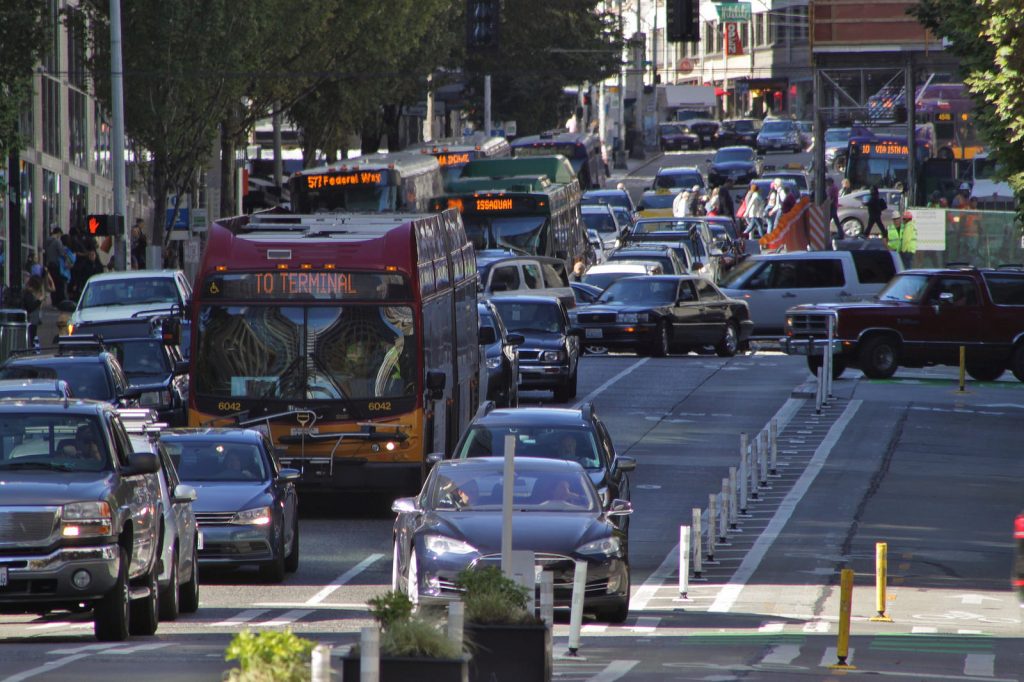During the first year of our Smart Cities Collaborative an overall theme emerged: how new technologies and new mobility are reshaping the right-of-way and curb space. Year two of the Collaborative will address these challenges head-on.
[alert color=”red”]Reminder: Applications for year two of the Collaborative are open until next Friday, February 16. Find out more information about eligibility and apply to participate here.
As we continue building a forum for collaboration and providing direct technical assistance to a new cohort of cities, the second year of the Collaborative will explore how new technologies and new mobility are reshaping the right-of-way and curb space. The content and curriculum will be separated into four sub-topics; design, measure, manage and price.
Over the coming weeks, we’ll publish in-depth posts on each of these topics and explain how we’ll approach them in the Collaborative. This is part one of a four-part series and our first topic will examine how the right-of-way and curb space are evolving and what cities can do to adapt.
Design

With rare exception, city streets across the United States were and continue to be designed, operated and managed for use by the single occupant automobile. The demands and conflicts created by existing competing needs and uses—ridehail pick up and drop off, increased delivery in residential and commercial areas, separated and combined lanes for bike and transit use, pedestrian crossing and safety—are substantial and widespread, but are currently being addressed on a piecemeal basis.
Solutions are frequently just band-aids, making amendments to the existing streetscape rather than fundamentally redesigning the street for new needs.
And then there’s the deployment of automated vehicles, and the impacts and implications of them on the design, operation and management of streets. Coupled with heightened demands for wayfinding kiosks, electric vehicle charging stations, sensor networks and other digital infrastructure, it is clear there is a need for new streets that can not only accommodate but embrace and maximize the benefits of the new mobility era.
The past few years have provided cities with a wake-up call on the need to reassess current street design and curb management guidelines in an effort to reclaim our streets as cherished public spaces for people, while still serving as critical arteries for traffic.
Instead of examining these issues through the limited lens of a single technology or piece of infrastructure (e.g. “How can we fit bikeshare in here?”), the Collaborative will take a comprehensive look at how the street of the future should look, feel and operate, and determine the policies, design guidelines and new infrastructure that will help cities get there. We’ll examine various street typologies, look at every use case and user for right-of-way and curbside space, explore the variety of technologies and new mobility infrastructure that may need to be deployed on a given street, and ensure that we’re making streets that are safer and more accessible to everyone that needs to use them.
Throughout the year, the Collaborative will work with participants to rethink their streets and address these new demands for roadway and curb space while making them more human-centered and friendly. The end result will be an accessible document that describes:
- The need for new approaches to our streets;
- Provides street typologies with design guidelines;
- Operation and management strategies;
- Performance measurements; and
- Pilot projects for cities to test.
Stay tuned for our next post on our second Collaborative topic this coming year—measure—and how a robust system of measuring performance along with using real-time data to inform operations and decision-making will prevent cities from getting lost in the web of information and help anchor projects in the service of achieving long-term outcomes.

Comments (3)
Tfor America is to be applauded for the effort you make to sell the concept of Mass transit few of the not poor think mass transit is anything but a subsidy for poor folks..
We who realistically see tomarrow as totally unlike yesterday in that all energy will be electric energy, not personally owned auto’s ! It just isn’t possible to produce electric cars “for all” and not exceed the energy allowable to every individual in a society, then we cannot allow people to have energy consuming items because “they can afford it” philosophy. We will make certain they can’t ! so in the world of tomorrow all will be taking the trolly biking or not going! Realining living quarers so that people who work at aaa can get to work people working at bbb will will move so that the aaa can get to work and home the 4 days a week the need to show up., All this is going to change the way people think about HOME …number one is “they will spend much more time in community than now” as they will be working 5 to 10 less hours less each week and work hours will gradually decline from that number as efficiency and robots are replacing their hours of work! This is the concern few think about except efficiency engineers and social planners.I’m out of space but not ideas..